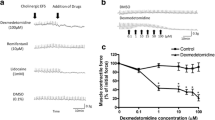Abstract
To gain insight into the cellular mechanisms involved in bronchodilation induced by inhalation anesthetics, we investigated whether halothane and enflurane can modulate functions of airway epithelium, such as epithelium-mediated bronchodilation and transepithelial transport. To measure the isometric tension of airways, paired rings of canine bronchi (4–6 mm OD), with and without the epithelium were mounted in Krebs-Ringer solution, gassed with 95% O2 and 5% CO2, and isometric tension was continuously recorded. To determine transepithelial transport, the posterior membranous portion of the trachea was mounted in Ussing-type chambers and the potential difference (PD), short-circuit current (SCC), and transepithelial resistance (R) were determined.
Halothane and enflurane increased the contractile responses of the trachea to acetylcholine (ACh) in strips either with or without epithelium. However, this enhancement of the contractile responses by volatile agents was much larger with the epithelium than without. Furthermore, halothane tended to gradually increase and then decrease SCC of the trachea, but these changes were not statistically significant. These results indicate that halothane may modulate contractile response of the isolated trachea to ACh, but has no effect on ion transport by airway epithelium. The responsiveness of the trachea may be regulated independently of ion transport by airway epithelium.
Similar content being viewed by others
References
Holgate ST, Beasley R, Twentyman OP (1987) The pathogenesis and significance of bronchial hyperresponsiveness in airways disease. Clinical Sci 73: 561–572
Morrison KJ, Gao Y, Vanhoutte PM (1990) Epithelial modulation of airway smooth muscle. Am J Physiol 258: L254-L262.
Moncada S, Palmer RMJ, Higgs EA (1991) Nitrous oxide: Physiology, pathophysiology, and pharmacology. Pharmacol Rev 43: 109–142
Hirshman CA, Edelstein G, Peetz S, Wayne R, Downes H (1982) Mechanism of action of inhalational anesthesia on airways. Anesthesiology 56: 107–111
Sugahara K, Freidenberg GR, Mason RJ (1984) Insulin binding and effects on glucose and transepithelial transport by alveolar type II cells. Am J Physiol 247: C472-C477
Cott GR, Sugahara K, Mason RJ (1986) Stimulation of net ion transport across alveolar type II cell monolayers. Am J Physiol 250: C222-C227
Sugahara K, Kiyota T, Baba T, Nakamura M, Morioka T (1989) Effects of autonomic agents and chemical mediators on ion transport by canine tracheal epithelium. Jpn J Physiol 39: 421–428
Rennard SI, Beckmann JD, Robbins RA (1991) Biology of airway epithelial cells. In: Crystal RG, West JB The lung: scientific foundations. Raven, New York, pp 157–167
Souhrada M, Souhrada JF, Cherniack RM (1981) Evidence for a sodium electrogenic pump in airway smooth muscle. J Appl Physiol 51: 346–352
Muldoon SM, Vanhoutte PM, Lorenz RR, Van Dyke, RA (1975) Venomotor changes caused by halothane acting on the sympathetic nerves. Anesthesiology 43: 41–48
Tessier GJ, Lackner PA, O'Grady SM, Kannan MS (1991) Modulation of equine tracheal smooth muscle contractility by epithelial-derived and cyclooxygenase metabolites. Respir Physiol 84: 105–144.
Shah WV, Hirshman CA: Mode of action of halothane on histamine—induced airway constriction in dog with reactive airways. Aesthesiology 65: 170–174
Koga Y, Iwatsuki N, Satoh D, Hashimoto Y (1987) Direct effects of isoflurane on airway smooth muscle; a comparative study with halothane and enflurane. Masui 36: 1257–1263
Korenaga S, Takeda K, Ito Y (1984) Differential effects of halothane on airway nerves and muscle. Anesthesiology 60: 309–318
Tobias JD, Hirshman CA (1990) Attenuation of histamine-induced airway constriction by albuteroi during halothane anesthesia. Anesthesiology 72: 105–110
Nijkamp FP, Van Der Linde HJ, Folkerts G (1993) Nitric oxide synthesis inhibitors induce airway hyperresponsiveness in the guinea pig in vivo and in vitro: Role of the epithelium. Am Rev Respir Dis 148: 727–734
Author information
Authors and Affiliations
About this article
Cite this article
Kiyota, T., Sugahara, K., Nakamura, M. et al. Effects of halothane and enflurane on epithelium-dependent contraction and ion transport of canine tracheal epithelium. J Anesth 8, 455–460 (1994). https://doi.org/10.1007/BF02514626
Received:
Accepted:
Issue Date:
DOI: https://doi.org/10.1007/BF02514626




